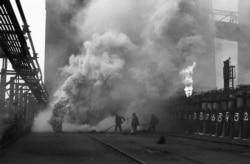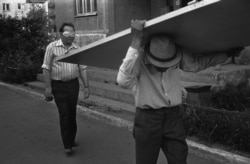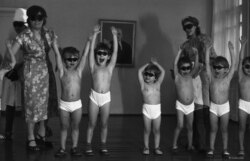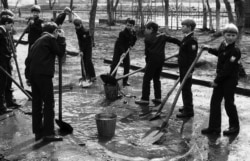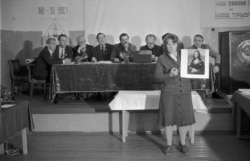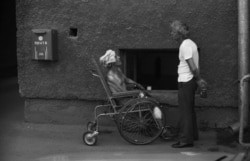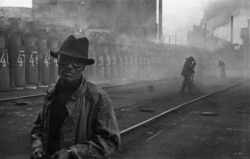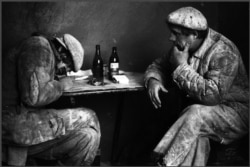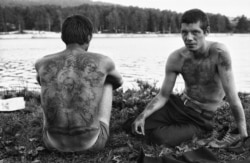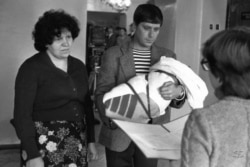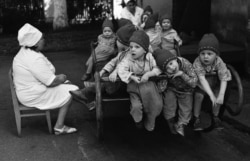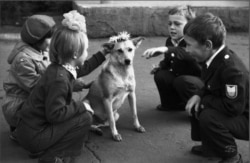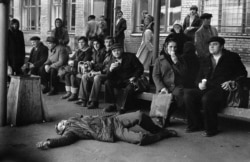In the late 1970s, three photographers -- Vladimir Vorobyov, Vladimir Sokolayev, and Aleksandr Trofimov -- got a job at the Kuznetsk Metallurgical Plant in the Siberian city of Novokuznetsk. Their task was to photograph the enterprise in all its glory. But a year later, the photographers caught the attention of KGB officers and were later declared "enemies of the state."
The three photographers called themselves the TRIVA group, and they produced a number of black-and-white photographs that showed a bygone Soviet era in an authentic light.
One of them, Aleksandr Trofimov, was asked by the Siberia Desk of RFE/RL's Russian Service whether they were aware of the impact of their work.
"Our photo lab had a task to reflect the life, activities, and achievements of the plant. It was an ordinary task. We, like photographers, didn’t do anything special. We just shot the daily life of production, people, and their way of life. And so the photographs started to not only reflect the life of people and their work, but also that epoch. It seems to me that we ourselves were actually not much different from the people we shot."
"We were all born during the 1940s and 1950s, and we all had similar complexes. What kind of complexes? Fear, for example. We were afraid of many things. But still, among a population thinking the same way, suddenly there were three of us who did not think like everyone else. The three of us worked day and night, slept at work, and lived the same life. We were united by the work that we were doing and we had a common idea: leave a memory of how people lived through our photographs, show what they did and who they were. I set myself only one rule -- no malice. Photograph only what is."
TRIVA photographers were able to work without staging shots because, among other things, they had modern professional cameras made by the Japanese Canon and German Leica brands.
"Imagine, in Siberia, in a mining town, among the exiles from different nations and eras, three young guys come to such a strategic enterprise and say: 'Buy us good cameras, and we will create a chronicle of the Soviet factory for you,'" says Oleg Klimov, a documentary photographer and founder of the Liberty.SU photography journal. "Wasn't that Komsomol (good communist) behavior? Could they be refused? Of course not!"
"Of course, they sincerely wanted to show the grandeur of the Soviet factory. But the more they photographed with their foreign cameras, the more they got a picture of 'an island of unbearable suffering.' And thank God, they were never Soviet photojournalists, never visited the Soviet briefings, and they were not told what is good and what is bad. They had their personalities and they were on their own."
The TRIVA group focused on work and social photography, following certain principles such as capturing the "time and place," portraying "truth for truth's sake," and observing a strict policy of noninterference in the event that was being photographed.
"Their photos show a bygone time," Klimov says. "Capturing time is the real talent of the documentary photographer, and not just pressing the shutter button. It is unlikely that they understood that they were creating a chronicle of the era. Millions of photos appear and disappear in time."
"The TRIVA group was special because they found the time and strength to realize and systematize their work. Not everyone succeeds in this and often archives of unique photographs are just thrown into the garbage. In this sense, of course, they perfectly understood that they had created a chronicle of this epoch. It is a great credit to Vladimir Sokolayev, who before passing away and through the illness of his last years, tried to systematize and preserve the memories of this era."
According to their colleagues, Trofimov, Vorobyov, and Sokolayev were known by everyone in the city, and so they were allowed to shoot where ordinary photographers were not permitted. But the attitude toward them changed when one of them decided that he wanted to send their work beyond the Iron Curtain to the prestigious World Press Photo contest.
"The year 1980 came and it was the year of the Olympics [in the U.S.S.R.]. Naturally, the country had to look respectable and so we got into the middle of it all. Sokolayev decided that he wanted to participate in World Press Photo," Trofimov recalls. "I told him: 'Why? You need to be a member of a printed press organization to participate, and we are not.' However, he decided everything in his own way, although Vorobyov and I tried to convince him otherwise."
Applications for World Press Photo went through Moscow. However, the photographs were returned from the capital to the Kemerovo regional party committee. There, they considered the photographs "a deliberate denunciation of the socialist way of life."
KGB officers came immediately to the photo lab.
"In the collectives of Novokuznetsk, letters were read aloud that denounced us as 'unreliable,'" says Trofimov. "I remember the amateur photographer Gena Morgunov stood in front of me and shouted: 'Rejoice that it’s not 1937, I would have shot you with my own hands!' But why? A day earlier we drank vodka together, and now he was ready to kill us!"
"Then it was scary: everybody knew if you were called an 'enemy of the state' there would be inevitable consequences. This also applied to children and wives. And we all had families," says Trofimov. "We offered to quit. Comrade Yagoditsyn, who was in charge of the cultural department at that time, got on his knees and apologized to the party bureau for overlooking the 'ideological bomb.' People came from the Central Committee and shouted: 'Here they are, enemies of the people! Anti-Soviets!' And we really didn't know how it would end."
Trofimov says that some people he knew would cross the street to avoid him because they did not want to greet him. Many photos were burned that year simply out of fear.
"I learned about this situation from his close friend," recalls Tatyana Sokolayeva, Vladimir Sokolayev’s sister. "I met him on the street and rushed to say hello, but he pushed me away and said: 'Your brother is a dissident!' I didn’t know what this meant; the newspapers didn’t write about it. And I realized that something terrible had happened. Although I knew that Volodya was never against the Soviet government. We lived simply in our own world and there was no reason to expect that this situation would arise."
"But, apparently, the guys themselves, perhaps without realizing it, went beyond the limits of where one could go, and it caused this reaction. Their photographs simply reflected their times: honestly, cleanly, without highlights, without makeup, without being profitable or right for someone. But it turned out that such honest work then was impossible and dangerous. Therefore, a friend of Vladimir's called him a dissident."
In 1981, the TRIVA group was officially disbanded by order of the Communist Party's regional committee. The life paths of the photographers diverged. Vladimir Sokolayev and Vladimir Vorobyev began devoting their attention to occultism and Eastern philosophy; they switched from social photography to landscape photography. Aleksandr Trofimov worked in various city photo studios. In the late 1980s, Sokolayev left Novokuznetsk to live and work in Moscow. Vorobyov and Trofimov, who remained in Novokuznetsk, did not communicate with each other.
"In these kinds of teams, very personal teams, it often happens this way,” says Klimov. "But there is one peculiarity in TRIVA that distinguishes them from most photo groups in the U.S.S.R.: They were able to recognize and preserve what they did. Otherwise today's young people would learn about the Soviet Union from the photographs of professional propagandists from the newspaper Pravda. But they can judge that era by the work of real documentary photographers who believed in justice and could only show their pictures to each other, while intuitively understanding that their photos would show a bygone era. And they did it right, we can be sure of that today."

